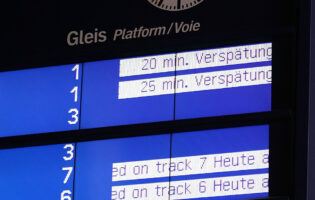
Nic Simanek via Flickr
The Saga of Berlin’s Long-Delayed Airport Opening

Nick Lokker
Georgetown University
Nick Lokker is a graduate student at Georgetown University’s Walsh School of Foreign Service, where he is pursuing his MA in German and European Studies. He has an academic focus on transatlantic security policy and EU-Russia relations. Nick previously worked for AICGS as a research intern during the summer of 2020. His duties included assisting the AICGS president and fellows with research as well as writing for the AICGS website.
Nick's other work experience includes internships with the Center for a New American Security's Transatlantic Security Program, the Center for European Policy Analysis, and the European Parliament. He speaks French, Spanish, and some German and Russian.
It’s finally happening: Berlin will soon have a new airport. After decades of repeated delays and mishaps, Berlin Brandenburg Airport (BER) is set to open this fall, with service beginning on October 31. Named after Willy Brandt, the former German chancellor and mayor of Berlin when the Wall went up, the new airport should provide a big boost to Berlin’s transport infrastructure, allowing for greater travel capacity as well as the closure of badly outdated Tegel Airport in the north of the city. It seems that completing such an essential upgrade would be an obvious priority for Germany’s bustling capital. Why, then, did it take so long to happen?
The idea for the airport was originally conceived in 1996, shortly following the establishment of Berlin as the federal capital of a reunified Germany. Identifying the need for a large modern airport to support the city’s new role, officials initiated a joint project among the city of Berlin, the state of Brandenburg, and the German federal government. This three-way division of responsibility has been a hurdle from the beginning, making it difficult to achieve consensus on various aspects of the plan. For example, in 2000 the Brandenburg regional court overruled a decision to ban international construction services Hochtief from bidding on the project, leading to a delay in securing financing. The airport’s proposed location in Schönefeld also sparked protests by residents of the area, preventing ground from being broken until after a federal court decision in 2006—the year initially envisioned for completion.
Once under construction, officials announced the airport would open in October 2011. While this date was eventually pushed back to the following year, in 2012 it appeared that the opening would really take place. That spring, thousands of volunteers participated in a trial of the airport’s infrastructure, as airlines and vendors prepared to open operations at BER. Many people had already bought tickets to and from the new airport. But on May 8, it was suddenly revealed that the opening would be delayed due to technical issues, in particular involving fire safety.
The 2012 disaster ultimately prompted the demise of Klaus Wowereit, Berlin’s mayor since 2001. Wowereit had played a central role in the development of the project through his position on its supervisory board, and spoke often of his “vision of a strong, internationally networked business location with a high-capacity airport.” After this vision repeatedly failed to materialize over the next few years as several more planned opening dates came and went, Wowereit resigned in 2014 over the mounting criticism.
The past six years have seen a series of further stumbling blocks, including more technical difficulties as well as revelations of corruption and mismanagement. One senior airport official accepted a €150,000 bribe from the firm responsible for building the faulty fire safety system, while many parts of the airport infrastructure were kept running at the taxpayer’s expense despite it being closed. This contributed to the exorbitant costs of the project, which are nearly triple its original €2 billion budget.
Late last year, however, there finally came an announcement of the new 2020 opening date. This time, officials say, it’s for real. So far there appears to be little cause for concern that the opening will be pushed back. While the COVID-19 pandemic disrupted plans for a test-run of the facility, delaying it by six weeks and reducing the number of participants, the trial did not uncover any technical flaws similar to those that derailed the 2012 opening. In fact, the reduced air traffic caused by the pandemic may actually make a timely opening more likely, as the airport can take a stepwise approach and gradually scale up capacity to prevent small glitches from escalating into larger problems.
Even if BER does in fact open this October as currently scheduled, the damage inflicted by its troubled history will remain. The numerous delays have significantly harmed Berlin’s reputation as a dynamic and efficient economic hub within the country, while the infrastructure of the airport has become outdated without ever being used. Furthermore, it has become less and less likely that BER will be able to supplant the established European hubs and play a primary role in the continent’s aviation sector, especially given the widely-held view that the current structure is already too small to accommodate Berlin’s air traffic.
What might we take away from all this? One thing is clear: the Berlin-Brandenburg airport is not an isolated incident within Germany. Recent years have seen numerous other large infrastructure projects such as Hamburg’s Elbphilharmonie and the Stuttgart 21 railway experience logistical issues of their own. A common theme throughout these debacles has been criticism of the over-involvement of politicians in the planning process. Perhaps this will serve as a reminder to put smart public policy over politics going forward.









